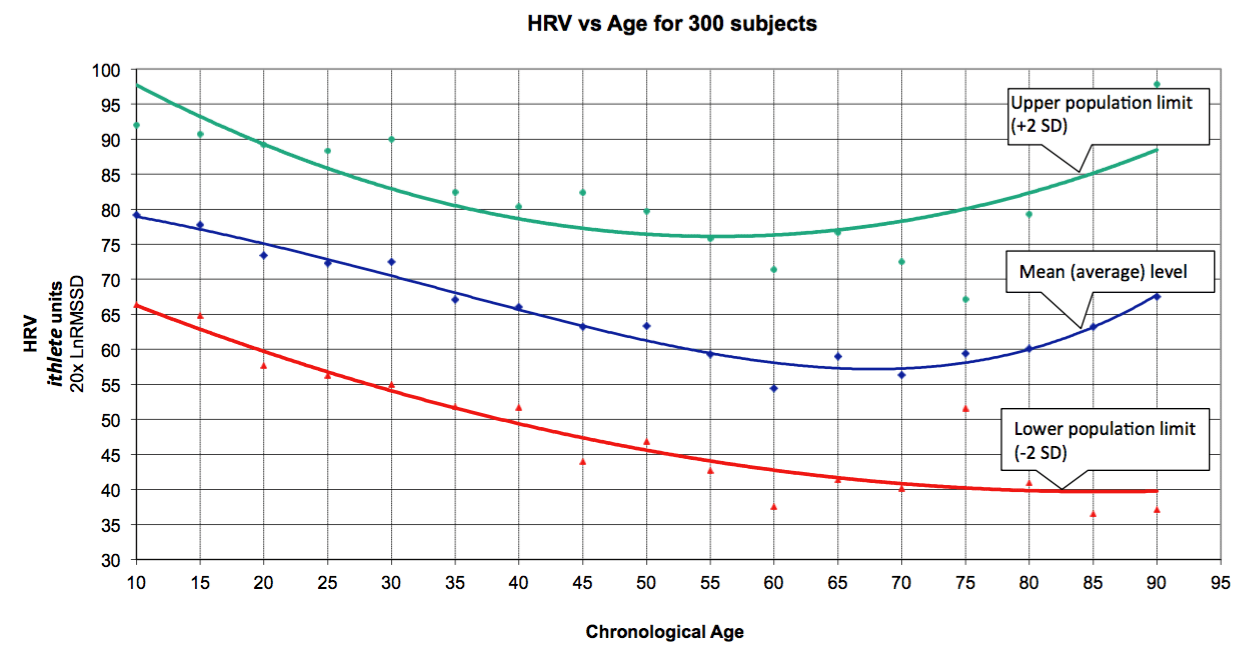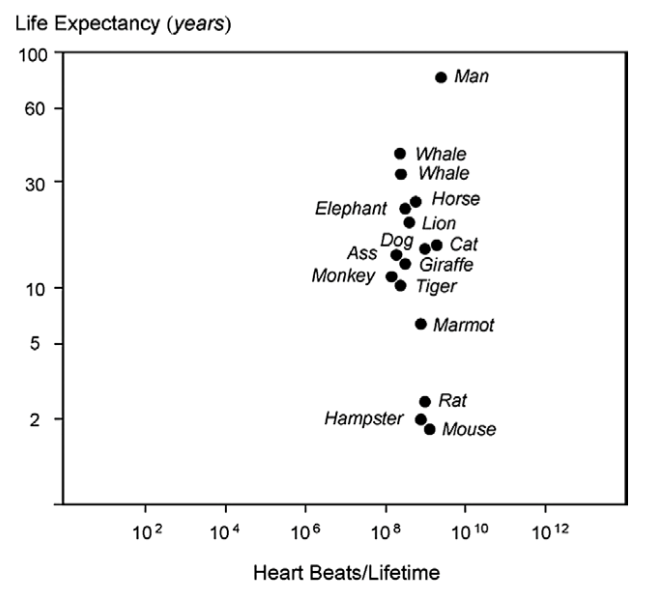by Simon Wegerif
Although heart rate variability (HRV) has been known about for centuries, and employed in critical medical monitoring, space exploration and elite athletics systems for many years, it was only when validated smartphone app ithlete appeared in 2010 that it became practical for athletes, sportspeople and biohackers to gain easy access to this revealing biomarker.
Prof Stephen Porges description of HRV as an ‘index of stress, and vulnerability to stress’ (1) has at least two important implications:
- HRV decreases with the total stress load placed on your body. This includes:
a) Physical stress e.g. from workouts and manual labour
b) Chemical stress from poor nutrition or toxins
c) Mental / emotional stress from work deadlines, relationships, etc.
2. The higher a person’s average (or baseline) HRV, the less vulnerable they are likely to be to stress from these sources.
It’s no big surprise then, that researchers have been looking for possible relationships between higher HRV and a longer lifespan.
Whilst all good studies report the age and other key demographic data of their subjects, it was in 2010 that researchers in Geriatric Medicine and Cardiology at the Chicago College of Medicine identified a need to better understand the physiologic markers predictive of healthy longevity. They suspected that preservation of good function of the autonomic nervous system, that regulates many of the body’s internal processes, might be important to preserve life in old age.
They recruited nearly 350 healthy subjects of both sexes ranging in age from 10 to 99 years around Chicago and in Northern California, and used portable Holter ECG monitors to record and calculate measures of HRV to a high degree of accuracy for a 24 hour period.
The published paper shows a scatter plot of the results, which although clearly showing a decline with age is not very easy to apply. So what we have done is to re-digitise all the individual data points for the parasympathetic data and plot this on the chart below as mean ± 2 Standard Deviations, i.e. approx. 95% of the population at a given age will be between these limits. The HRV scale is the one created for ithlete, 20x Ln RMSSD.

What they discovered was that measures of parasympathetic (rest and digest) HRV exhibited a rapid decline between the ages of 20 and 50. The rate of decrease then slowed, reaching a minimum in the 70s. After this, they found an increase in HRV for the very oldest subjects.
The fact that HRV declines throughout life for the population as a whole suggests that preservation of autonomic function could be important to healthy survival into old age. It is especially interesting to see the higher values of parasympathetic HRV in the very oldest members of society. The authors offer a couple of different explanations as to why this might be:
- That only the people with high levels of HRV in their younger years survive longer than average or
- That lifestyle modifications (i.e. healthy living) help preserve autonomic functions into later life.
It’s also interesting that beyond the age of 60, HRV distribution seems to bottom out at approximately 40 units on the ithlete scale. In other research papers, a level of less than 15ms RMSSD has been suggested as a level below which mortality risk increases.
More recently, a distinguished body of Silicon Valley Doctors and Entrepreneurs came together to create the PaloAltoPrize.org to stimulate research into anti-ageing techniques and have put up $1m in prize money for the first teams that are able to demonstrate restoration of health in an ageing mammal to that of a young adult. They’ve taken a bold stand by declaring HRV as the single key metric for autonomic capacity, which is thought to be the key is restoring the body’s ability to repair itself (rather than just the reduction of current symptoms). The initiative is led by Dr Joon Yun, who is interviewed on the Quantified Body.
Another recent commentary in the journal of the American Heart Association (3) took the perspective of looking at the relationship between resting heart rate and life expectancy:

Studies were quoted which looked at the total number of heartbeats of 15 different mammal species, calculated as average heart rate x average lifespan, and found that they came out within a narrow range around 1 billion heartbeats. The connection was drawn between high HRV, signifying a parasympathetic dominant state and low heart rate at rest. The authors pointed out that routine exercise is an especially effective way of reducing not only resting heart rate, but also the 24hr average including the raised HR during exercise.
No doubt someone in the Quantified Self community has already calculated how many heartbeats they have remaining, and also what is the optimum volume and intensity of exercise to spread those remaining heartbeats over the longest time span!
In summary, Prof Porges’ statements about HRV being an index of stress, and vulnerability to stress are well born out by the findings of a population study, in that it does seem that HRV, and the body’s ability to repair itself declines naturally with age, reaching a minimum in the 70s. Living for longer and remaining healthy seems to depend on a good genetic makeup (so that your HRV begins and continues above average levels for your age), or on lifestyle choices that boost HRV or most likely a combination of both.
References
- Pediatrics.1992 Sep;90(3 Pt 2):498-504. Vagal tone: a physiologic marker of stress vulnerability. Porges SW1 http://www.ncbi.nlm.nih.gov/pubmed/1513615
- Usman Zulfiqar, MD, Donald A. Jurivich, DO, Weihua Gao, PhD, and Donald H. Singer, MD., 2010. Relation of High Heart Rate Variability to Healthy Longevity. American Journal of Cardiology 2010; 105:1181–1185
- Exercise, Heart Rate Variability, and Longevity The Cocoon Mystery? Paul Poirier, MD, PhD, FRCPC (Circulation. 2014;129:2085-2087.) © 2014 American Heart Association, Inc. Circulation is available at http://circ.ahajournals.org DOI: 10.1161/CIRCULATIONAHA.114.009778

No doubt someone in the Quantified Self community etc….// Brilliant ;-)
Very interesting. However, if I understand this correctly, I would have to do my HRV measurement over 24 hours – I’d appreciate knowing if this is what is meant.
At 79, with three morbidities (cancer, hypertension, and chronic kidney disease), I wonder whether my own average morning readiness LnRMSSD x20 of 56.6 or that of my average LnRMSSD x20 when doing high intensive interval training of 71.4 is more indicative of where I would be on the graphs.
Hi Ian,
You don’t need to do an entire 24 hr measurement (though you could do a 24hr RR data capture using our Precision Pulse app then calculate RMSSD in Excel), but what I would recommend is performing a small series of 1 min measures and averaging the results to reflect typical posture changes during an ‘average’ 24 hr period. So perhaps do one in bed before going to sleep, one in the morning whilst lying down, one mid morning standing, one late morning seated, and one mid afternoon seated.
Add them all up and divide by 5.
Do report back on what you find!
If my average HR is 70 bpm and I multiply that by 60 mins in an hour and 24 hours in a day and 365 days in a year, then that comes to 36 million heartbeats a year. 1 Billion divided by 36 million means a 28 year lifespan – something wrong with your 1 Billion statement me thinks. (I think the writer has simply looked at the graph and made that statement, without understanding that it is a logarithmic scale and therefore small shifts across the X axis make huge differences)
Indeed – the log scale needs to be read with some precision, and the referenced chart from the Journal of the AHA is not really suitable for that. A thought that occurs is that in earlier times before modern medicine, life expectancy was in the mid 40s, which would tend to put the Human point on the chart closer to the other animals. In current times, with an average adult 24hr HR of 74 bpm (http://eurheartj.oxfordjournals.org/content/4/1/44) and a life expectancy of 82 years, this would require 3.2 Bn heartbeats.
For anyone interested in working out whether exercise allows you to be more efficient with the use of heartbeats, this recent article is good: http://www.cyclist.co.uk/in-depth/1313/will-riding-use-up-my-heart-beats
The x scale is not logarithmic, it is in engineering notation. Log scale is 1, 10, 100, 1000, 10.000 … and so on.